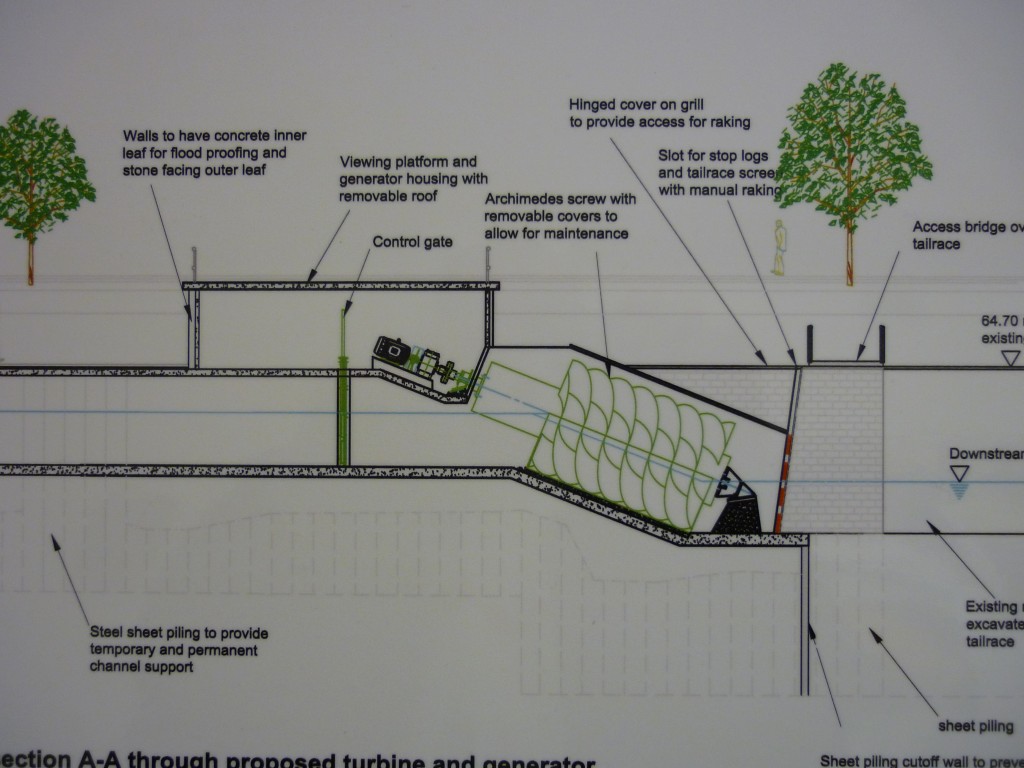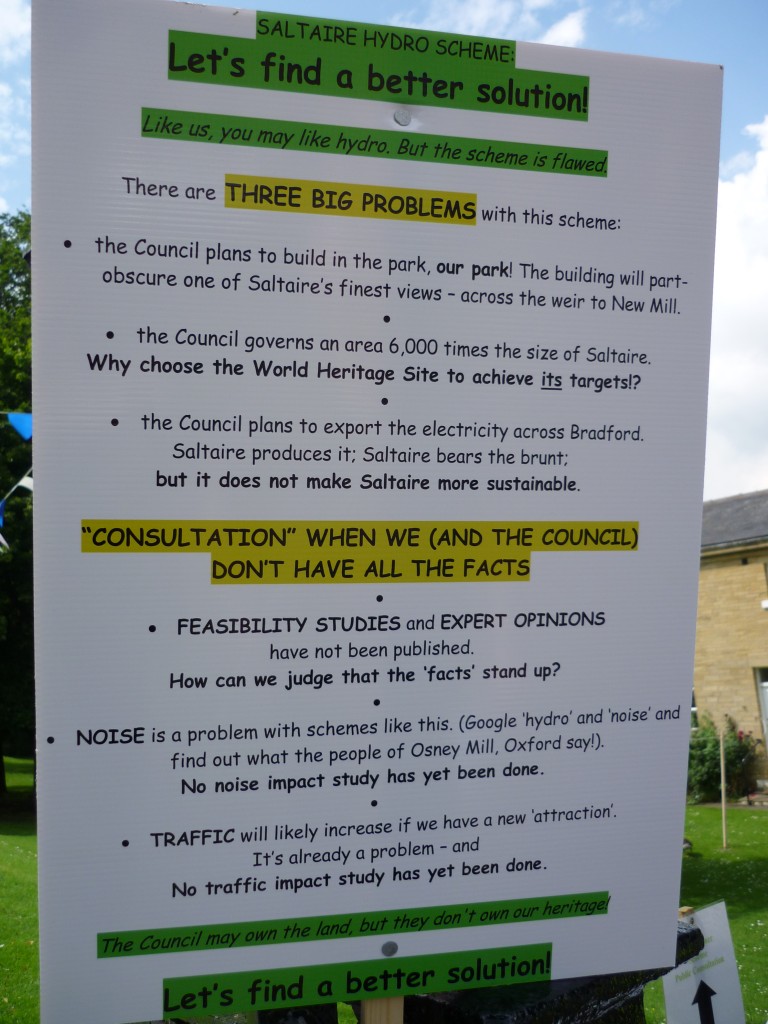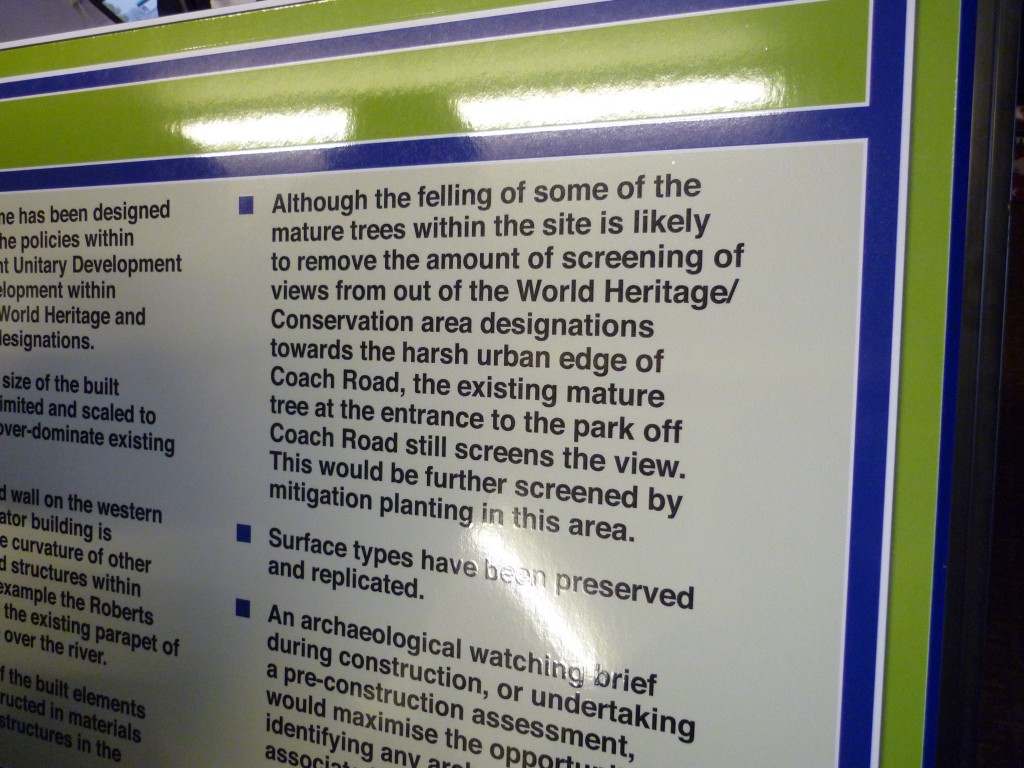The hottest water issue in Saltaire at present (sorry, no pun intended) is Bradford Council’s proposal to install a hydro-electric power generator — an Archimedes screw – on the River Aire at Saltaire weir. The controversy raging is around the fact that the site proposed is within the grounds of Roberts Park, which Bradford Council owns, but which it is by no means free to do with as it wishes. The argument against the installation can be simply summarised as follows: “the project changes the use of a recreational park space, and has no place in a protected park, in a protected conservation area, in a protected World Heritage Site.”
Those words appear about half-way through a document titled “Reasons to be Doubtful”, which has been carefully prepared by “a group of concerned villagers” (no author is identified). The latest, September version of this document (it continues to evolve as more information becomes available) was the key persuading factor in the decision last week by the Saltaire Village Society to come out in opposition to the proposals. (See news report here.) A copy was provided to me by Rob Martin, chair of the SVS, and also coincidentally one of the performers in our Blue Route canal tour. His fellow performer on the boat will be Eddie Lawler, who remains in favour of the hydro proposals — just one small indication of the way that this plan has divided the local community. It’s a very sensitive issue, with strong arguments on both sides.
So what’s the argument in favour? At a public consultation about the proposals at Saltaire’s URC Church on July 5th this year, the signage on the way into the church’s basement exhibition space made the Council’s case pretty unambiguous:
 Technically, of course, building a renewable energy plant constitutes “mitigation” of climate change rather than “adaptation” to it. That is, it helps reduce carbon emissions (all other things being equal), but does nothing to prepare us for adverse or extreme weather… Most scientists are now in little doubt that we need to be doing both, so the hydro plan is part of Bradford’s response those uncomfortable realities – and at least it is doing something! The Council’s main persuasion tactic seems to be to appeal to the green sensibilities of the local population: Shipley ward elects the only Green councillors on Bradford Council, after all (even if the MP, Philip Davies, is a climate change sceptic!).
Technically, of course, building a renewable energy plant constitutes “mitigation” of climate change rather than “adaptation” to it. That is, it helps reduce carbon emissions (all other things being equal), but does nothing to prepare us for adverse or extreme weather… Most scientists are now in little doubt that we need to be doing both, so the hydro plan is part of Bradford’s response those uncomfortable realities – and at least it is doing something! The Council’s main persuasion tactic seems to be to appeal to the green sensibilities of the local population: Shipley ward elects the only Green councillors on Bradford Council, after all (even if the MP, Philip Davies, is a climate change sceptic!).
 Presumably we could add “Support renewable energy schemes in your area” to the bottom of that list… But what the Council have not done very clearly here is link this notion of global change, global responsibility, to the particularities of a local place. And it’s often difficult for people to see what difference small, local changes will make to the big, global picture (even though a lot of small changes might add up to a big one!).
Presumably we could add “Support renewable energy schemes in your area” to the bottom of that list… But what the Council have not done very clearly here is link this notion of global change, global responsibility, to the particularities of a local place. And it’s often difficult for people to see what difference small, local changes will make to the big, global picture (even though a lot of small changes might add up to a big one!).
It seems to me that the Council could have been much more explicit about admitting that the choice of Saltaire weir for this hydro scheme is as much a symbolic one as a practical one — that it’s a showcase scheme designed to draw public attention to the wider need for a switch to renewable energy. The objections to the scheme in the “Reasons to be Doubtful” document mostly relate to the inappropriateness of placing a power plant in a recreational park: indeed the authors make the point that such usage may contravene the terms of the deed of gift by which the Roberts family gave the park to the City in the 1920s. But if the hydro is constructed and displayed in such a way as to add to the interest value of the park for visitors, then the installation would presumably be enhancing the park’s “recreational and amenity value” rather than detracting from it. And clearly that is the intention here… You only have to look at the aesthetically rendered visions of the hydro installation on display at the July 5th consultation…

 This diagram image, and its keenness to interpret and explain, seems to reflect a key aspect of the hydro plan — i.e. that it should serve as a pleasantly-designed educative exhibit, as well as a working power generator. None of this seems to me inherently objectionable in a conservation area or World Heritage Site, especially given that the return to “water power” signalled by the hydro installation also symbolises a cyclical return to the site’s own history. The weir is here in the first place because it once served a water mill – Dixons Mill – that stood on the southern bank before Salts.
This diagram image, and its keenness to interpret and explain, seems to reflect a key aspect of the hydro plan — i.e. that it should serve as a pleasantly-designed educative exhibit, as well as a working power generator. None of this seems to me inherently objectionable in a conservation area or World Heritage Site, especially given that the return to “water power” signalled by the hydro installation also symbolises a cyclical return to the site’s own history. The weir is here in the first place because it once served a water mill – Dixons Mill – that stood on the southern bank before Salts.
In point of fact, even the protest lobby against the scheme seems to be aware that the hydro installation might add to the amenity and visitor value of the park. How else to explain the last point on the placard below? (sited at the ‘picket’ point outside the July consultation)
 That final point suggests that increased traffic congestion might result from the added ‘attraction’ value of the showpiece hydro installation. And yet at the same time, there’s the assumption that it will be a burden (“Saltaire bears the brunt”) and an eyesore (obscuring views). The argument is somewhat self-contradictory, and perhaps somebody pointed this out to the ‘No’ campaign: it’s telling that the “traffic” objection is nowhere apparent in the September “Reasons to be Doubtful” document.
That final point suggests that increased traffic congestion might result from the added ‘attraction’ value of the showpiece hydro installation. And yet at the same time, there’s the assumption that it will be a burden (“Saltaire bears the brunt”) and an eyesore (obscuring views). The argument is somewhat self-contradictory, and perhaps somebody pointed this out to the ‘No’ campaign: it’s telling that the “traffic” objection is nowhere apparent in the September “Reasons to be Doubtful” document.
I have to say that I’m not convinced, either, about the suggestion that ‘iconic’ views will be spoiled by the installation: if you go down and look a the proposed site at present, the views from it are already partially obscured by self-seeding riverside foliage growing out the banking. Purely in aesthetic terms, the designs for the installation would appear to be an improvement, visually. The “Reasons to be Doubtful” document does mention that pulling out trees (presumably these ones) is an environmental no-no. Yet a much more substantial swathe of riverside greenery was pulled up during the Lottery-funded improvements to the park only a few years ago – precisely in order to clear the views from the cricket pitch to the bridge, Boathouse and Salts Mill…
But I’m digressing. Let’s return to the key argument. If one accepts the proposition (and plenty of people don’t!) that a hydro of this sort is a kind of showcase exhibit, with a symbolic and educative value beyond its purely practical, energy-producing function, then most of the objections in the “Reasons to be Doubtful” document fade away pretty quickly. “There is only a modest green gain.” Well yes, nobody ever said water could be harnessed to enormously powerful effect (there’s a reason we once switched to steam mills from water mills!). The point is not that this one hydro would generate huge amounts of energy, but that many similar, small-scale schemes up and down our river catchments (coupled with other schemes to create power from wind, waves, waste, etc.) might start to make a difference to our fossil-fuel dependency. “This scheme represents poor value for money.” Perhaps, but by the “Reasons…” document’s own reckoning, the additional cost in comparison with – say – the hydro at Hirst Mill being proposed by Sustainable Saltaire, is mostly caused by the need to make the installation appropriately presentable in a protected heritage context. Again, that price might well be worth paying for the public showcase value. And besides, Bradford Council’s figures, even at the conservative end, indicate that this hydro would pay for itself within a decade or so.
The “Reasons to be Doubtful” document does, however, ask a few searching questions about the green credentials of the scheme. Has anyone calculated what the actual carbon expenditure would be to install the hydro in the first place? Because without such an estimate, we can’t be sure what the net energy savings would really be of such a scheme, as opposed to the gross power generated. Not only that, the document refers to this proposed hydro as a “token gesture”… If it is to have symbolic value as a public exhibit of the virtues of green energy, it needs to be evident that it not tokenistic, but one scheme among many (the showcase scheme among many) that Bradford Council is developing. Otherwise it really would be just window-dressing, or “greenwash”. So there are still questions that need to be answered persuasively by the Council.
And perhaps the most persuasive argument on the “anti-” side is simply that the gestural value of installing such a showcase turbine does not stack up against the potential inconvenience value to the local community… Roberts Park was largely closed off for redevelopment work only a few short years ago, and although nobody disputes that the result is a vast improvement on what was there before, the prospect of part of it being dug up again so soon is understandably off-putting. This is the point that Rob Martin emphasised recently in a piece for the Saltaire Sentinel: “[visitors] would be walking next to a building site for the 14 to 18 months, and it will be even longer before the site resembles anything like the artist’s impression of the finished article. It seems to be very high price for a little bit of sustainable energy.” The counter-argument here, I suppose, is something along the lines of “you don’t make an omelette without cracking a few eggs.” So again, it all comes down to a question of how much you want that omelette.
There are, as I said at the outset, strong arguments on both sides here – although it’s probably clear which side of the debate I favour (and hey, I can afford to: I don’t live in Saltaire and won’t live with the inconvenience of the construction). What I find disturbing in this, however, is the insularity of the way the debate has been framed by some on both sides. The anonymous “concerned villagers” behind the “Reasons to be Doubtful” document seem to have forgotten that they don’t actually live in a “village” entire unto itself, but in a district of Shipley, which is a district of Bradford… But look again at that placard I photographed above – “in our park,” “we” shouldn’t be having to export energy “across Bradford”. Whoever wrote that needs to ask themselves where they get their “own” food, clothing and energy from. Saltaire village is not yet a self-sufficient co-operative. But equally, the Council pitch on July 5th seemed to be pandering to the same presumed, insularised village mentality. Check this out:
 I’m not sure I’ve ever seen this “harsh urban edge of Coach Road”. In fact, the Coach Road housing estates, lying on either side of the park, were carefully planned by Shipley Urban District Council, back in the 1950s, precisely in order to preserve the “rural aspect” of the surrounding area (Shipley Glen, Baildon Moor, Hirst Wood…). You can see that especially with the very sensitive design of the Higher Coach Road estate (which will shortly be the subject of another blog posting). Unfortunately, the words “harsh urban edge” seem here to function as code for “those people over there in the housing estates” – wouldn’t it be nice to “screen” them off from “our” park? Well, folks, those people (many of whom are very lovely people, by the way) live in this area too, and the park is on their side of the river.
I’m not sure I’ve ever seen this “harsh urban edge of Coach Road”. In fact, the Coach Road housing estates, lying on either side of the park, were carefully planned by Shipley Urban District Council, back in the 1950s, precisely in order to preserve the “rural aspect” of the surrounding area (Shipley Glen, Baildon Moor, Hirst Wood…). You can see that especially with the very sensitive design of the Higher Coach Road estate (which will shortly be the subject of another blog posting). Unfortunately, the words “harsh urban edge” seem here to function as code for “those people over there in the housing estates” – wouldn’t it be nice to “screen” them off from “our” park? Well, folks, those people (many of whom are very lovely people, by the way) live in this area too, and the park is on their side of the river.
As park-keeper Martin Bijl is keen to emphasise, the policy of Roberts Park is – quite rightly – to be inclusive and inviting for people from both the north and sound of the river, and indeed from much further afield. In a World Heritage Site, we need to be thinking in terms of a global village.

Neill Morrison, Energy Manager at Bradford Council and the man responsible for the hydro plan, read this blog and emailed me with a useful clarification on the question of ‘net carbon gain’, mentioned above: “schemes of this type are assessed to have an energy payback of between 30 and 300 over their life,” he notes, which is “the best energy payback of any technology. This means that a small scale hydro scheme will generate between 30 and 300 times the energy used in construction over the generator’s life.” So that pretty convincingly deals with the net/gross argument. Thanks Neill!
Council officers including Neill have had to admit if government feed in tariffs change ( they are up for review, by no means set in stone) this project will be unviable. The business case for this scheme is yet to be proved. There is an alternative on the other side of the weir in New Mill. This is what it was designed for, Titus was using renewable energy 150 years ago, without it impacting on the park !
Ps. Saltaire is Unesco listed. This is a site of international importance, we are merely custodians and have a responsibility to make sure Saltaire gets the very best care. In that sense it is our park because we are closest to it.
I would query Sharon Ashton’s statement above that “Titus was using renewable energy 150 years ago.” I know of no evidence that this is the case. The weir at Saltaire was built to service the three water wheels of Dixons Mill, which stood on the site for 200 years before Salts. Sir Titus’s operation, however, was steam-driven (and thus used non-renewable coal supplies), and the original Salts Mill was by the canal, not by the river (a canal has no water power to speak of). As I understand it, New Mill utilised the old Dixons mill race as a water supply, but nobody I have spoken to about this believes that the waterwheels were ever put back into operation.